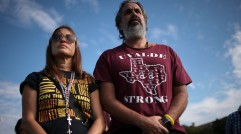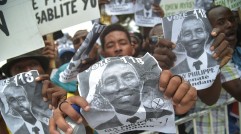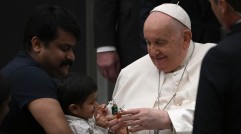Metropolitan Opera Review 2015-16 -- 'Tannhauser': Westbroek, Botha, Mattei, Levine Shine in Wagner Gem
This review is for the performance on Oct. 12, 2015.
Presentations of Wagner operas at the Met are becoming yearly treasures with the company only showcasing one of the master's seminal masterworks. A year ago, Wagnerites got an opportunity to see "Die Meistersinger von Nurnberg," a treat after the 2013-14 season featured no Wagner works.
The 2015-16 season's Wagner opera, "Tannhauser," is yet another must-see revival for those interested in the transcendent experience of the German composer's musical greatness.
Set in Medieval Germany, the opera narrates the story of Tannhauser, a minstrel who has abandoned his home seeking the pleasures of the Goddess of Love Venus. However, after spending time with her, he longs for a return home to his beloved Elizabeth, who has no idea where he has been. During a Song Contest, Tannhauser lets the secret out of the bag, drawing the revulsion of everyone. Elizabeth defends her man from certain death, but Tannhauser is forced to head to Rome to receive absolution from the Pope.
The opera has been preserved in a nuanced production by director Otto Schenk. The 1977 production still holds up rather well over the course of the night, with Schenk using Wagner's narrative structure to inform his choices. Acts 1 & 3 are visual mirrors, both showcasing an inclination in the upstage left area. There is a tree stump downstage left and a statue on the opposite end of the stage as well for both acts. Most of the first act finds Tannhauser laying on the ground asleep; in the final act this innocent gesture is inverted by Elizabeth laying down on the ground praying for her beloved. Act 1 is mainly lit for daylight while the third act is dominated by night. Tannhauser ends Act 1 walking off in triumph through the aforementioned inclination; Elizabeth's final moments of the third act see her move chillingly into the shadows, a powerful representation of her fate. The Venusberg makes appearances in both acts; in Act 1 Venus' home is front and center while the third act has her in the background all the way upstage.
The second act, in which civilization and the song contest take shape, might be the most impressive set of all. Visually, Schenk and set designer Gunther Schneider-Siemssen created a circular space that is symmetrical in almost every single respect; the lone exception are the two seats where Elizabeth and Landgraf Hermann are to sit. It unbalances the composition ever so slightly initially but hints at the imbalance the entire scene will undergo when Tannhauser makes his fateful revelation. Throughout this sequence, Schenk plays with the idea of balance and imbalance in his compositions and stage, particularly during the end of the act where Tannhauser is relegated to one side of the stage and his opponents draw their swords on the other. This is by no means revolutionary stage direction, but it is effective and powerfully expressive.
South African tenor Johan Botha brought his elegant singing to the title role. He has become a staple of this repertoire at the Met, his voice always sounding comfortable in Wagner's most complex musical gestures. He was vibrant and energetic in the early going of the night, but his real highlight came in the third act during Tannhauser's big monologue during which he expresses the tragic events he underwent in Rome. Here the singing shifted from a rather somber and delicate tone before slowly but surely growing into a sharper and bitter quality. Botha's phrasing shifted from connected legato to more disconnected attacks, emphasizing the character's anger at the entire situation. The tenor had no need for any major physical gestures here as he drew the audience into rapture while sitting on the tree stump.
Peter Mattei enjoyed a fine evening as Tannhauser's friend Wolfram, who also harbors love for Elizabeth. Mattei has one of the most graceful baritones in the opera world, and he put it to its most beautiful use in the role. There was never any sense of forcefulness in Mattei's singing on the night, every utterance breezing over the audience suavely. It was a beautiful counterpart to Botha's weightier and even coarser deliver throughout, emphasizing how different these two men really are. Everyone turns to the glorious "O, du mein holder Abendstern" as the benchmark for any Wolfram and Mattei generated one of the most memorable moments of the evening, delivering the iconic piece with warmth and delicate legato phrasing.
Arguably the most impressive performance of the night came from Soprano Eva-Maria Westbroek as Elizabeth. As the curtain rose on Act 2, she was a fretful, nervous and yet hopeful young girl lifted by the power of love. Her singing during that first section "Dich, teure Halle" was brimming with vitality, Westbroek's voice washing the auditorium with sound. Her duet with Tannhauser was equally riveting with Westbroek's Elizabeth a nervous lover constantly looking to her Tannhauser for a reciprocation of his devotion. When he touched her face late in the scene, Westbroek's face was filled with tremendous pleasure, a beautiful moment that revealed the depth of the character's love and desire for Tannhauser. She punctuated that scene by singing with exuberance, so much so that it rose over the orchestra and slightly overpowered Botha.
As she defended Tannhauser, Westbroek's voice found another gear and resonated over the massive choral passages. Near the end of the act, there is a reversal of "the touch on the face," this time by Elizabeth over a fallen Tannhauser. She seemed hesitant to touch the object of her affection but, after a few moments, opted to do it. Whereas his touch was a moment of sensual ecstasy for her, this one hurt both her and Tannhauser in equally painful measure.
In the third act, Westbroek's voice floated ethereally throughout the prayer, the energy and massive tone of the opening "Dich, teure Halle" transformed into pianissimo singing that paralyzed the audience. This passage, which is in complete contrast to the propulsive nature of Elizabeth's opening "aria," is far more expansive and Westbroek clung to every note as if it were her last, a glorious manifestation of Elizabeth's emotional and physical predicament. There were two other visceral moments in this act from Westbroek, neither of which included singing. As the chorus of pilgrims sang of returning home, Westbroek ran about the stage look at each one to see if her Tannhauser had returned. The desperation here was potent, driving the scene into a painfully tragic dimension. Finally, as she walked off stage, her pace was ghostlike, as if Elizabeth had already died in that moment. The singing-actress had the viewer's complete attention with every labored step she took, feeling her anguish in every single moment.
Michelle DeYoung sang with a voluptuous sound expressing the sexual drive of Venus, her stare and gaze filled with sensual desire. Gunther Groissbock finally got an assignment worthy of his luxurious bass. He polished singing carried beautifully in the role of Hermann, and one could feel a powerful father-daughter connection between him and Elizabeth. At one point he was even excited to see Tannhauser, saluting him with special reverence prior to the song content. When he turned on the minstrel, his voice took on a harsher complexion, the delivery of the German consonants more punctuated and the voice rising to another aural level. Ying Fang sang with silky tone as the young shepherd while the remaining cast members filled in admirably to balance out a remarkable ensemble.
The chorus, so crucial to this opera, was on point in every assignment it was tasked with. Undeniably the moment of greatest success came in the third act Pilgrim's chorus, the haunting opening lines growing and growing until they filled the Met with exhilarating sound at the apex of the passage.
In the pit James Levine, delivered as polished a performance as one could hope from this Wagnerian master. The overture started off gently, Levine pulling out the most delicate sounds from the winds and horns. Levine expanded the tempi in the early going, bringing out every rich harmony and emphasizing the arrival of each string section thereafter. It allowed the introduction to grow, the tension ratcheting up slowly but surely until the cathartic explosion of sound of the horn chorale. In this most glorious of moments, Levine upped the tempo, the strings excited accompaniment breezing through and driving the passage ever forward. The second section of the overture, expressing the excitement of Venusberg was a far faster tempo and added a notable contrast between the hard-earned sublimity of the pilgrim theme with the easier pleasures of the Goddess of Love.
The third act's prelude was haunting to say the least. Throughout this passage, Wagner shifts from winds to strings continually, keeping the two sections of the opera apart until they eventually unite in quietly tragic dimensions. Again, Levine stretched the tempi, allowing the dark mood of the act to set in.
In many ways "Tannhauser" provides an ideal launching point for those who want to try out Wagner but might feel daunted to do so. Unlike "The Flight Dutchman" which has no intermissions, "Tannhauser's" has two and showcases the composer's most structured work. Arias, choruses even concertato's are easily discernible throughout opera, giving audiences concrete points of reference. Throw in this terrific cast, a conductor at his very best and a production that despite its age still holds up, and you have a glorious evening for both newcomers and Wagner lovers alike.
Subscribe to Latin Post!
Sign up for our free newsletter for the Latest coverage!














